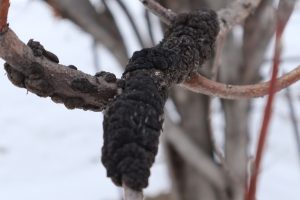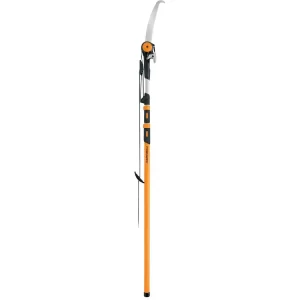 What is Black Knot?
What is Black Knot?
Black Knot (Apiosporina morbosa) is an extremely aggressive fungal tree disease. It mainly targets Mayday and Chokecherry trees in the Edmonton region. The fungus spores travel by air from tree to tree between spring and early fall. It becomes active in the spring once temperatures reach 10-15° C consistently.
Affected trees grow ugly, tar-like swellings on branches. If left untreated the fungus has the potential to kill the tree over time. As long as there’s full foliage the individual knots are hard to spot. However, the full impact is visible in late fall and during winter months when the leaves drop or once the foliage becomes sparse as the tree suffers. Best practice is to clip out any fungus as soon as detected.
How to get rid of Black Knot?
Unfortunately the typical black tar-like swellings are only evident after a couple of seasons once infected. Affected branches are hard to spot when the fungus is in it’s younger stage. Although there are chemical products available to cure the disease the best way is to physically remove the knots.
Removal is done best between fall and late winter, when the tree is dormant and without leaves. Cut the branch 6-8 inches below the knot or back to a healthy collar, rather than leaving a stubby branch. Cutting tools should be cleaned and disinfected after each cut, especially if you’ve cut through a knot. You can either use a bleach solution or isopropyl alcohol. Best is to keep the solution in a spray bottle. Do not break off knots/branches by hand, always use a sharp cutting tool for a clean cut. This will help the tree closing the cut faster and more easily. A clean cut also minimizes other infections/diseases. Once the fungus has moved into the main trunk the tree’s survival is drastically reduced.
Any cut offs must be destroyed immediately, either by bagging and disposing with household garbage or better yet by burning. Do NOT keep infested cut off branches in your yard. The spores can remain active (which will mean they can still spread the disease) for up to 4 months even after cut off.
Tools & Tips
For most trees you will need an extendable pole pruner to reach up into the canopy. The Fiskars brand offers affordable and sufficient homeowner solutions.
The more work you can do from standing on firm ground the safer you will be. Using ladders with large tools can be dangerous. Tip for efficiency and time saving: Have a second person assist you with the disinfection process after each cut and cleanup the cut branches while you simply focus on cutting the affected branches. For safety reasons it’s best to do the work with little to no snow on the ground.
It is not uncommon to have trees with recurring fungus infestation. This is simply because the fungus infection is very hard to spot in its first season as the knot has not grown big enough to make out from ground level. Also, since the fungus spreads with airborne spores it can come back from other trees. Keeping a vigilant eye on your Mayday and Chokecherry tree and cutting off any affected branch immediately will give your tree the highest chance of survival. Trees with severe fungus infestation may need to be removed altogether.
If you suspect to have Black Knot on one of your trees please give us a call as quick as possible or contact your trusted arborist.






